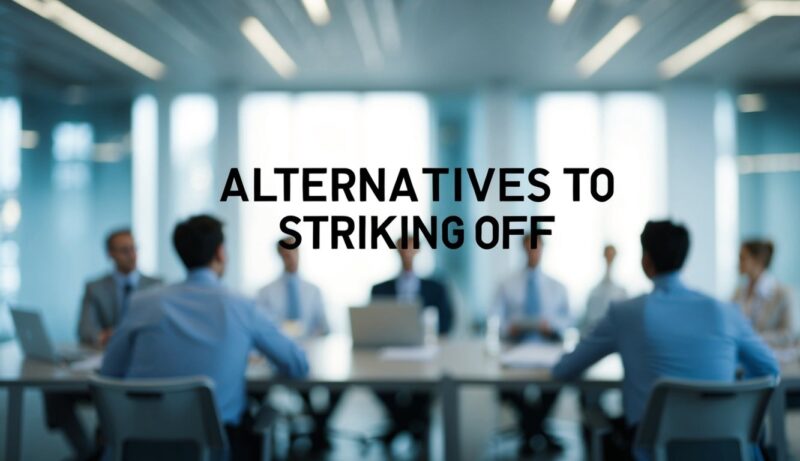Alternatives to Striking Off: Exploring Your Options for Company Closure
When the time comes to close your company, there are several options available beyond simply striking off. While a strike-off can be a cheaper alternative to voluntary liquidation for solvent companies, it may not always be the most suitable choice.
This article aims to explore the various alternatives to striking off, helping you make an informed decision on the most appropriate method for closing your business. From creditors’ voluntary liquidation (CVL) to company voluntary arrangements (CVAs), we will assess the options available, ensuring you find the most cost-effective and efficient way to close your company while adhering to all legal requirements.
Quick Summary: Alternatives to Striking Off
Voluntary liquidation (MVL): Suitable for solvent companies – it distributes assets to shareholders and settles debts.
Creditors’ voluntary liquidation (CVL). For insolvent companies, enabling structured debt settlement and closure.
Administration. Protects the company from creditors while restructuring or seeking a buyer.
Company sale. Transfers ownership to a new party and can be useful if the company still has value or potential.
Dissolution with preparation. Ensures all liabilities and assets are dealt with before closing.
Merger or acquisition. Combines the company with another entity allowing continuation under new management.
Dormancy. Keeps the company registered without trading. It avoids immediate closure.
Restructuring. Adapts the company to resolve issues and often makes striking off unnecessary.
Free Consultation – advice@andersonbrookes.co.uk or call on 0800 1804 933 our freephone number (including from mobiles).
When Striking Off Isn’t the Best Choice
Striking off may not always be the ideal option for closing a company. There are circumstances where alternative approaches are necessary or more beneficial. Let’s explore two key scenarios where striking off might not be the best choice.
Insolvency and Liquidation
If your company is insolvent, striking off is not a viable option. Insolvency occurs when your company’s liabilities outweigh its assets or it can’t pay debts when they’re due. In this situation, you must consider liquidation instead.
Liquidation involves selling company assets to pay creditors. There are two main types:
- Creditors’ Voluntary Liquidation (CVL): You initiate this process
- Compulsory Liquidation: Creditors force the company into liquidation
Attempting to strike off an insolvent company is illegal and can lead to serious consequences. Creditors may block the strike-off or reinstate the company to recover their losses. Directors could face personal liability or disqualification.
Selling the Business
If your company has value, selling it might be a better alternative to striking off. This option allows you to potentially profit from your hard work and preserve the business as a going concern.
Steps to consider when selling your business:
- Valuation: Get a professional valuation to determine a fair price
- Preparation: Organise financial records and contracts
- Finding buyers: Use business brokers or online marketplaces
- Negotiation: Be prepared to discuss terms and price
- Due diligence: Allow potential buyers to review your company thoroughly
Selling can be more complex than striking off, but it may yield financial benefits and ensure the continuity of your business under new ownership.
Comparing Alternatives
When considering alternatives to striking off, it’s crucial to carefully evaluate your options. Comparing different approaches can help you make an informed decision that best suits your company’s circumstances and goals.
Liquidation vs Administration
Liquidation and administration are two distinct processes for insolvent companies. Liquidation involves selling off assets and closing the business permanently. You’ll appoint a liquidator to handle this process, which typically results in the company ceasing operations.
Administration, on the other hand, aims to rescue the company or achieve a better outcome for creditors than liquidation. An administrator takes control to restructure the business or sell it as a going concern. This option may preserve jobs and maintain business relationships.
Key factors to consider:
- Time frame: Liquidation is generally quicker
- Cost: Administration can be more expensive
- Business continuity: Administration offers a chance of survival
- Creditor outcomes: Administration may yield better returns for creditors
Merging with Another Business
Merging with another company can be a viable alternative to striking off, especially if your business is struggling but has valuable assets or market share. This option allows you to combine resources, reduce overheads, and potentially create a stronger entity.
Benefits of merging:
- Access to new markets or technologies
- Increased efficiency through shared resources
- Potential for growth and improved financial stability
Challenges to consider:
- Cultural integration issues
- Possible job redundancies
- Complex legal and financial negotiations
You’ll need to identify a suitable merger partner and conduct thorough due diligence. Engage legal and financial advisors to guide you through the process and ensure compliance with regulatory requirements. Remember, a successful merger requires careful planning and execution to realise the potential benefits.
Explore Alternatives to Striking Off – Speak to an Expert
When considering closing your company, it’s crucial to explore all available options. Striking off might seem straightforward, but it’s not always the best choice.
An insolvency expert can guide you through alternative routes that may better suit your situation. They can assess your company’s financial status and advise on the most appropriate course of action.
Some alternatives to striking off include:
- Members’ Voluntary Liquidation (MVL)
- Creditors’ Voluntary Liquidation (CVL)
- Company Voluntary Arrangement (CVA)
- Administration
Each option has its own advantages and implications. An expert can explain these in detail, helping you make an informed decision.
If your company has assets exceeding £25,000, an MVL might be more tax-efficient than striking off. For insolvent companies, a CVL could be the most suitable path.
Speaking with an expert also ensures you’re complying with all legal obligations. This is particularly important if your company has outstanding debts or unresolved issues.
Remember, choosing the wrong closure method can have serious consequences. You might face personal liability or director disqualification if you strike off an insolvent company.
To protect yourself and make the best choice for your business, reach out to a qualified insolvency practitioner. They can offer tailored advice based on your specific circumstances.
Frequently Asked Questions
Business owners considering alternatives to striking off their company often have important questions about the process and options available. The following FAQs address key differences, legal implications, and financial considerations to help inform your decision.
What are the main differences between voluntary strike-off and liquidation?
Voluntary strike-off is a simpler, less formal process for closing a solvent company. It involves applying to Companies House to remove the company from the register. Liquidation, on the other hand, is a more complex legal procedure that involves appointing a liquidator to wind up the company’s affairs, sell assets, and distribute proceeds to creditors and shareholders.
How does voluntary winding up differ from striking off a company?
Voluntary winding up is a formal liquidation process initiated by shareholders. It requires passing a special resolution and appointing a liquidator. Striking off is less formal and doesn’t involve a liquidator. Winding up is typically used for larger companies or those with significant assets, whilst striking off suits smaller, dormant companies.
In what ways can insolvency law impact the decision between striking off and other alternatives?
Insolvency law plays a crucial role if your company is insolvent or facing financial difficulties. It may prevent you from striking off the company if there are outstanding debts. In such cases, you might need to consider alternatives like administration or creditors’ voluntary liquidation to comply with legal obligations and protect creditors’ interests.
How can preparing a cash flow forecast help a business avoid the need for striking off?
A cash flow forecast can provide valuable insights into your company’s financial health. By projecting future income and expenses, you can identify potential cash shortages early. This allows you to take proactive measures, such as reducing costs or seeking additional funding, to improve your financial position and potentially avoid the need for striking off.
What steps should be taken to find out if anyone has objected to a company’s strike off process?
To check for objections to your company’s strike off, regularly monitor the London Gazette for notices. Contact Companies House directly to enquire about any objections received. Review your company’s mail and registered office address for any official correspondence regarding objections. If objections are raised, you’ll need to address them before proceeding.
What are the financial implications of choosing Members’ Voluntary Liquidation (MVL) instead of strike-off?
MVL can be more tax-efficient for shareholders when distributing assets over £25,000. It allows for capital gains tax treatment rather than income tax. However, MVL involves higher costs due to the appointment of a licensed insolvency practitioner. Consider the value of your company’s assets and potential tax savings when weighing up MVL against strike-off.
You may also be interested in:
Anderson Brookes Reviews

&





